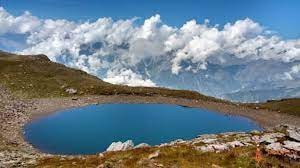The Bhrigu Lake walk is regarded as one of the best short treks in Himachal. It is a three-day trek from Manali that takes you through some spectacular grasslands and stunning scenery. If you are planning a trip to Manali and want to incorporate some hiking into your itinerary, the walk to Bhrigu Lake is an excellent choice. There are various travel firms that organize this trek that can be found both online and in Manali. You can, however, try it on your own if you so desire. Except for the winter season, the trail is well defined and easy to travel. During the trekking season, you will also encounter a plethora of other activities.
The trek’s difficulty rating is a beginner to intermediate, and it may be performed even by those with little to no prior trekking experience. All you need is a reasonable degree of fitness. In this article, we will look at how you can arrange your trip.
How to reach Bhrigu Lake
To go to Bhrigu Lake, you must first travel to Manali. This is the most straightforward part of the voyage. Manali is one of our country’s most popular hill destinations, and it is accessible year-round via a motorable route. If you are driving or riding a motorcycle, the route will be as follows, beginning in Delhi. It will take you roughly 14 hours to get there from Delhi. The trip time from Chandigarh will be between 8 and 10 hours. There are regular buses to Manali from every major city in the vicinity. You can either take a state-run bus like the HRTC or a private tour operator.
Lake Trek Itinerary
Because the journey is easily possible in three days, the majority of trekkers will attempt to complete it in three days. However, if you have an extra day and want to spend more time in the beautiful green meadows, you can choose the 4-day itinerary as well. Any time spent traveling to Manali and then returning will be added to these days. For example, if you are traveling from Delhi, the trek will take 5 days. If you traveled by car, I would suppose you arrived in Manali the day before and are now ready to move on to the Rola Kholi camping. In any case, your first stop will be Gulaba, a little village around 22 kilometers from Manali. If you purchased your trip through a tour organization, they will organize transportation and will pick you up from either the hotel or the bus station. If you are going alone, there is an hourly bus that runs from Manali to Gulaba. If a bus is not available, you can take a shared taxi. The journey starts near the Gulaba checkpoint. You’ll trek through dense forest for almost an hour and a half before arriving in Jonker Thach.
My recommendation is that you continue on to Rola Kholi, a meadow about 5 kilometres ahead of Jonker Thach. Except for a sharp incline soon after Jonker Thach, the hike is not challenging. The remainder of the hike takes you through a beautiful grazing area used by the local shepherd. Throughout the trek, you will have a clear and breathtaking view of the Hanuman Tibba and Seven Sisters peaks. It will take you roughly 4-5 hours to walk 7 kilometers from the Gulaba checkpoint to Rola Kholi. You’ll spend the night here along a brook named Chor Nallah. At Rola Kholi, the elevation will rise from 2,050 metres (6,726 feet) to 3,830 metres (12,560 feet).
Best Time for Bhrigu Lake Trek
Bhrigu Lake is only open for 4-5 months of the year. Due to its high elevation, the lake and the walk are buried under snow until April and cannot be attempted. The path opens in May, and even then, there will be a lot of snow on the trail. In October, after four months of summer and monsoon, it begins to snow again. As a result, the only season you can visit Bhrigu Lake is from June to September. It is possible to attempt it in May and October as well, but it is entirely dependent on the weather. From November to April, the trail is blocked. You can hire a personal guide and go on a winter trek, but you’ll just be walking through the snowy hills. There will be no lake to sight, but there will be white snow all around. Personally, I would suggest going in September. All of the rainfall would have brought the entire region’s flora to life. The grasslands, natural springs, meadows, and waterfalls would be a sight to behold. The mountains would appear to have been washed clean and covered with a green carpet.


![The Rise of Loan Affiliate Marketing: Strategies That Actually Work The financial affiliate industry has seen explosive growth in recent years, with loan products becoming one of the most profitable verticals. As consumers increasingly turn to digital platforms for financial assistance, loan affiliate marketing is emerging as a reliable and scalable income stream for savvy affiliates. In this article, we’ll explore why loan affiliate marketing is growing so rapidly, which strategies are working best in 2025, and how Lead Stack Media — the USA’s best loan affiliate program — helps marketers dominate this niche. What Is Loan Affiliate Marketing? Loan affiliate marketing is a performance-based model in which affiliates promote financial loan products — such as personal loans, payday loans, or installment loans — and earn commissions for generating leads, completed applications, or approved borrowers. Affiliates typically drive traffic through: SEO and content marketing Paid advertising (Google Ads, native ads) Social media funnels Email marketing campaigns When done right, loan affiliate marketing can deliver high conversions and substantial payouts, especially with access to exclusive offers. Why Loan Affiliate Marketing Is Booming in 2025 Several factors are contributing to the rise of this high-value affiliate vertical: 1. Increased Demand for Digital Lending Millions of Americans are seeking quick access to funds — often online and without traditional banking hurdles. This has created a consistent, evergreen demand for personal and payday loan products. 2. High-Payout Offers Loan affiliate offers often pay $75–$250+ per approved lead. Compared to other verticals, this makes finance one of the most rewarding for affiliates. 3. Multiple Sub-Niches You can target a wide range of borrowers: Bad credit loans Emergency cash loans Student loans Debt consolidation No credit check loans 4. Data-Driven Optimization With modern tracking tools and split testing, affiliates can scale profitable campaigns quickly. Networks like Lead Stack Media provide real-time analytics to refine every aspect of your funnel. The Foundation: Choosing the Right Affiliate Partner The network you choose plays a huge role in your success. Many affiliates fail because they join general networks with low-converting, saturated offers. Instead, opt for a specialized and trusted program like Lead Stack Media, which offers: ✅ Exclusive, high-converting loan campaigns ✅ Weekly payouts and strong EPCs ✅ Custom creatives and funnel templates ✅ Legal and compliance support ✅ Dedicated affiliate managers who care about your growth Lead Stack Media is regarded as the top loan affiliate program in the USA — and for good reason. Top Strategies That Actually Work in Loan Affiliate Marketing Now let’s dive into the proven strategies that successful affiliates are using to win big in 2025: 1. SEO-Driven Content Marketing Search Engine Optimization (SEO) is a long-term strategy that offers compounding returns. Focus on ranking for keywords with high intent and low competition, such as: “Best loans for bad credit in [2025]” “Apply for emergency loan online” “Get $2,000 loan today – no credit check” Create in-depth blog posts, product reviews, and loan comparison articles. Include CTAs and banners that drive traffic to exclusive offers from Lead Stack Media. Pro Tip: Use schema markup, FAQ sections, and internal linking to boost visibility in Google search results. 2. Native Ads & Advertorial Funnels Native advertising via platforms like Taboola, Outbrain, or Revcontent allows you to blend your ads into the look and feel of editorial content. Pair your native ad with a pre-sell article (also known as an advertorial), such as: “How This Mother of Two Got a $3,000 Loan Approved in 10 Minutes” Drive readers to a Lead Stack Media landing page with a compelling CTA like “Check Your Loan Eligibility Now.” Native ads tend to have high engagement and lower CPCs than traditional display or search ads. 3. Paid Search Campaigns (Google Ads) If you're experienced with Google Ads, targeting high-intent keywords in the loan space can bring massive returns. Focus on: Keyword match types (exact and phrase) Localized targeting (state or city-based campaigns) Strong ad copy with compliance built-in Mobile-first landing pages Lead Stack Media provides ad copy examples and guidance to help you stay compliant and profitable. 4. List Building and Email Marketing Building a list of subscribers allows you to: Promote multiple loan products over time Segment based on user behavior (clicks, opens, interest) Re-engage non-converting leads through drip sequences Send 3–5 follow-up emails after a lead opts in with subject lines like: “You May Still Qualify for a $2,500 Loan – No Hard Credit Check Required” Note: Always follow CAN-SPAM and GDPR guidelines. 5. Funnel Optimization and Retargeting A fully optimized funnel makes the difference between a breakeven campaign and one that earns $1,000+ per day. Use retargeting via: Facebook Pixel Google Display Network Email re-engagement You can also optimize your landing page by testing: Button colors Trust badges (SSL, testimonials) Loan amount sliders Short vs long form CTAs Lead Stack Media provides A/B-tested pages and custom funnel support for all affiliates. Common Mistakes to Avoid in Loan Affiliate Marketing Even experienced marketers sometimes struggle in the loan niche. Avoid these pitfalls: ❌ Promoting non-compliant or misleading offers ❌ Sending traffic directly to the lender without warming them up ❌ Not segmenting traffic based on device or credit tier ❌ Ignoring data and failing to optimize campaigns Working with a high-quality network like Lead Stack Media eliminates many of these problems by giving you compliant offers, support, and tools right out of the box. Why Lead Stack Media Is the Best Choice for Loan Affiliates Thousands of affiliates trust Lead Stack Media because the platform was built by performance marketers, for performance marketers. What makes them the best in class? ✅ Exclusive access to top loan offers you won’t find on public affiliate networks ✅ Advanced tracking systems with real-time reporting ✅ Weekly payments via ACH, PayPal, or crypto ✅ Hands-on account managers who provide real business coaching ✅ Custom landing pages, email creatives, and ad templates ✅ Compliance support and pre-approved marketing materials Whether you’re new or experienced, Lead Stack Media helps you start fast and scale big. The Future of Loan Affiliate Marketing In 2025 and beyond, loan affiliate marketing will continue to grow as financial technology and consumer demand intersect. Here’s what to expect: Greater personalization of offers based on credit profile and geography AI-powered ad testing and lead scoring Deeper integration with BNPL (Buy Now Pay Later) and fintech solutions Stricter regulations — making compliant offers from trusted networks even more valuable If you want to stay ahead of the curve, now is the time to double down on this vertical — and partner with the right affiliate network. Conclusion: Start Winning in the Loan Vertical Today The rise of loan affiliate marketing is not a fluke — it’s a result of high consumer demand, attractive payouts, and accessible digital tools. But not every affiliate program is built for long-term success.](https://www.factsnews.co/wp-content/uploads/2025/06/121234-768x546.jpg)

